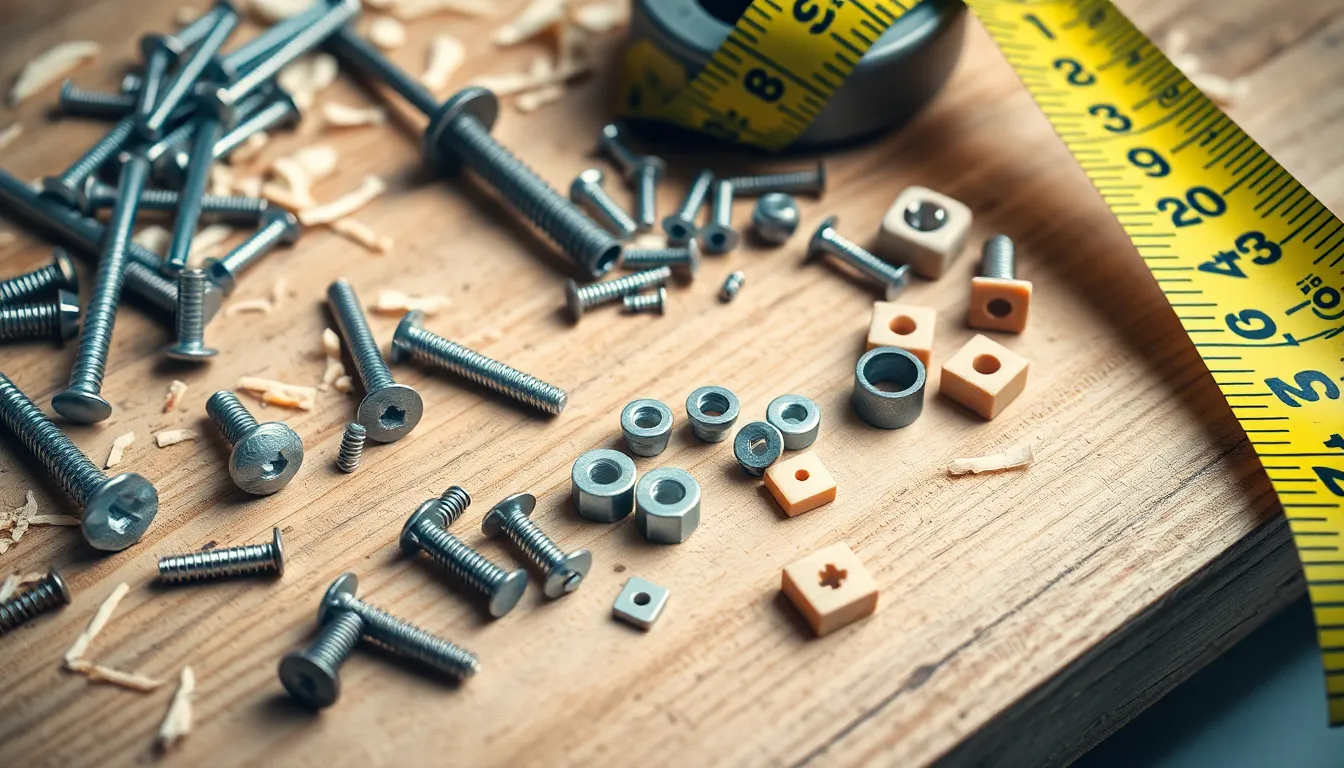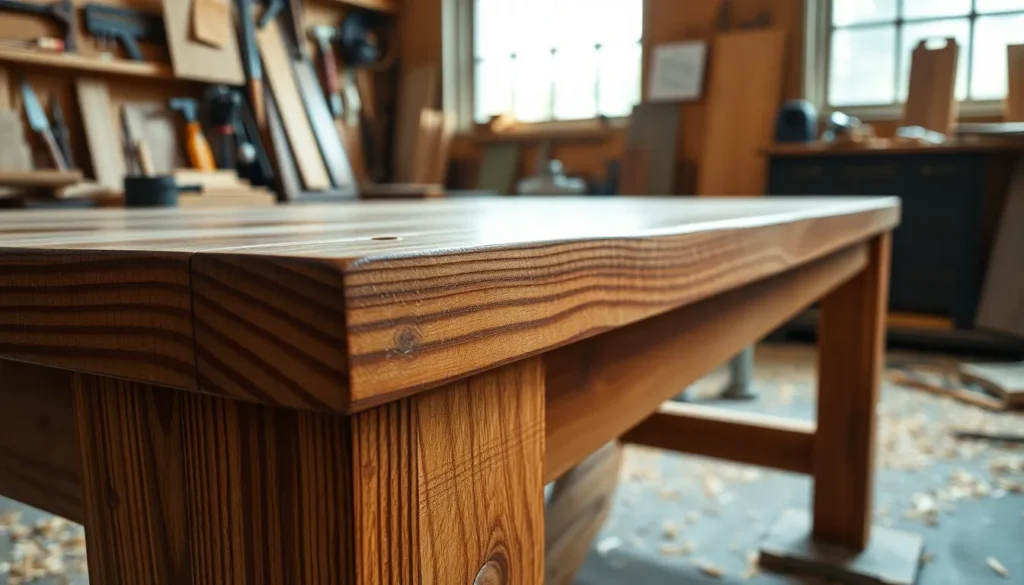In the world of woodworking, fasteners are the unsung heroes holding everything together. Without them, your dream project could easily turn into a wobbly disaster. Imagine crafting a beautiful table only to watch it collapse like a house of cards at the first family gathering. Not the kind of legacy anyone wants to leave behind!
Woodworking Fasteners
Fasteners play a pivotal role in woodworking, ensuring that joints remain secure and projects stand the test of time. Without adequate fasteners, even the most expertly crafted pieces can suffer structural failure. Screws, nails, and brackets serve as common examples of fasteners, each designed for specific applications.
Wood screws feature a threaded shaft, providing superior grip in wood, metal, and other materials. These fasteners typically come in various sizes, allowing for flexibility in different project requirements. Nails, with their simple design, offer quick application, making them ideal for joining thinner materials. They often work well in projects where speed is essential.
Bolts offer a reliable solution for heavy-duty applications, often used in larger constructs like furniture frames or cabinetry. The combination of a nut and bolt yields enhanced strength compared to traditional screws or nails. Additionally, brackets can provide added support, especially in joints that bear significant weight. They typically come in various configurations, including L-shaped, corner, and flat styles, accommodating different requirements.
When selecting fasteners, consider the material and thickness of the components. Understanding the right fastener type ensures a stable join. For instance, using a longer screw for thicker wood prevents splitting, enhancing the joint’s strength. Prioritize fasteners based on project demands, available materials, and desired longevity.
Choosing the correct fasteners saves time and enhances safety in woodworking. Adequate fastening solutions minimize the risk of failure during use, assuring a higher level of project durability. Focus on understanding each fastener’s characteristics to make informed decisions, resulting in successful woodworking outcomes.
Types of Woodworking Fasteners

Woodworking fasteners come in various types, each serving unique purposes in projects. Understanding these options enhances the selection process, ensuring stability and durability.
Screws
Screws are ideal for creating strong, lasting joints. They feature threaded shafts that grip wood fibers tightly, preventing loosening over time. Wood screws, often made of steel, are prevalent due to their strength and availability. Self-tapping screws streamline the installation process by eliminating the need for a pre-drilled hole. Using the right length and type ensures the best fit for different wood thicknesses and applications.
Nails
Nails offer quick assembly for various woodworking tasks. They come in different sizes and gauges, making them suitable for everything from framing to trim work. Ring-shank nails enhance holding power thanks to their ridged shafts, while finishing nails provide a smooth appearance for visible joints. The straightforward installation process allows for efficient workflow, ensuring projects progress quickly.
Dowels
Dowels provide a strong, hidden joint option, facilitating alignment without visible fasteners. Wooden dowels insert into matching holes in adjoining pieces, enhancing stability. When glued correctly, they form robust and durable connections. Additionally, dowels allow for easier disassembly compared to screws and nails, making them practical for furniture construction.
Biscuits
Biscuits are small, oval-shaped pieces of wood that fit into slots cut into adjoining boards. They help align and strengthen joints in various woodworking applications. Typically made from compressed wood, biscuits expand when glued, creating a firm bond. The biscuit joinery technique simplifies alignment and offers versatility for edge joints and corner joints, improving the overall aesthetic of the project.
Choosing the Right Fastener
Choosing the right fastener enhances the stability and durability of woodworking projects. Careful selection impacts both functionality and overall success.
Factors to Consider
Material type influences fastener choice. Woodworkers should match fasteners to wood species for optimal performance. Thickness affects required fastener length; thicker materials often need longer fasteners for a secure hold. Environmental factors matter too; consider moisture levels when selecting outdoor fasteners. Corrosion resistance is essential for longevity in varying conditions. Load-bearing capacity plays a vital role; heavier projects necessitate stronger fastening options.
Applications for Different Fasteners
Fasteners serve specific purposes in woodworking. Screws excel in creating strong, long-lasting joints, making them ideal for structural work. Nails offer quick assembly in less load-bearing applications, such as trim work. Heavy-duty projects often require bolts, providing unmatched strength. Dowels deliver hidden joints, suitable for furniture construction and repair, while biscuits offer alignment and strength, particularly in panel joins. Selecting the appropriate fastener based on these applications ensures successful craftsmanship.
Installation Techniques
Proper installation techniques ensure the effectiveness of woodworking fasteners. Using the right tools and practices enhances the strength and durability of joints.
Tools Required
Selecting appropriate tools is crucial for successful fastener installation. Woodworkers typically need a drill or screwdriver for screws, a hammer for nails, and a wrench for bolts. Additionally, clamps provide stability while joints cure. A measuring tape accurately guides placement, while a square ensures precision. A level checks alignment, helping to maintain an even structure throughout the project.
Best Practices
Adopting best practices ensures optimal fastener performance. Start by pre-drilling screw holes to prevent wood splitting. Ensure the fastener depth matches material thickness for a secure fit. Use pilot holes for accurate nail placement, reducing the risk of damage. When using dowels or biscuits, align pieces precisely for a stronger bond. Finally, always check for concealed knots before fastening, as these can compromise joint integrity.
Maintenance and Care
Maintaining woodworking fasteners ensures their optimal performance over time. Regular inspections can identify rust, corrosion, or damage that could compromise stability.
Ensuring Longevity
Selecting corrosion-resistant fasteners enhances lifespan, especially in high-moisture environments. Storing fasteners in a dry place prevents rust formation. It’s also beneficial to apply a protective finish on visible fasteners to create an additional barrier against environmental factors. Cleaning fasteners with a damp cloth removes any debris or dust, preventing buildup that may affect functionality. Proper installation techniques contribute significantly to longevity, as ensuring that fasteners are not over-tightened avoids unnecessary strain on joints.
Troubleshooting Common Issues
Identifying and resolving issues related to woodworking fasteners requires attention to detail. Loose joints often indicate inadequate fastening, which can be remedied by tightening or replacing the fasteners. If wood splits during fastening, pre-drilling can prevent further damage. Rusty fasteners may need replacement, as corrosion weakens structural integrity. Misaligned joints can result from inaccurate fastener placement, and realigning the materials or using spacers can fix this problem. Lastly, uneven surfaces can lead to instability, necessitating adjustments in the attachment process to achieve a secure fit.
Conclusion
Understanding woodworking fasteners is essential for anyone looking to create sturdy and reliable projects. The right fasteners not only enhance the durability of work but also ensure safety and functionality. By carefully selecting fasteners based on specific applications and materials woodworkers can achieve superior results.
Proper installation techniques further maximize the effectiveness of these fasteners while regular maintenance helps prevent issues that could compromise stability. With the right knowledge and tools woodworkers can confidently tackle any project knowing their fasteners will hold strong. Ultimately investing time in understanding and selecting the best fasteners pays off in the quality and longevity of woodworking creations.

